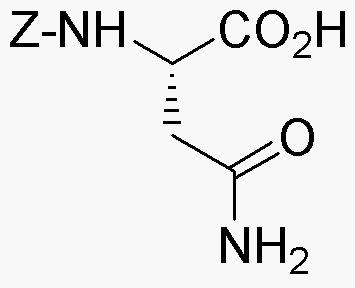Na-Z-L-asparagine is widely utilized in research focused on:
- Biotechnology: It serves as a key amino acid in the production of recombinant proteins, enhancing yield and stability in various biopharmaceutical applications.
- Cell Culture: This compound is essential in formulating culture media for mammalian cells, promoting optimal growth and viability in laboratory settings.
- Neuroscience Research: It is used in studies investigating neurotransmitter functions, particularly in understanding the roles of amino acids in brain signaling pathways.
- Food Industry: Na-Z-L-asparagine can be utilized as a flavor enhancer or nutritional supplement, contributing to the amino acid profile in fortified foods.
- Pharmaceutical Development: It plays a role in drug formulation processes, particularly in stabilizing active ingredients and improving bioavailability.
General Information
Properties
Safety and Regulations
Applications
Na-Z-L-asparagine is widely utilized in research focused on:
- Biotechnology: It serves as a key amino acid in the production of recombinant proteins, enhancing yield and stability in various biopharmaceutical applications.
- Cell Culture: This compound is essential in formulating culture media for mammalian cells, promoting optimal growth and viability in laboratory settings.
- Neuroscience Research: It is used in studies investigating neurotransmitter functions, particularly in understanding the roles of amino acids in brain signaling pathways.
- Food Industry: Na-Z-L-asparagine can be utilized as a flavor enhancer or nutritional supplement, contributing to the amino acid profile in fortified foods.
- Pharmaceutical Development: It plays a role in drug formulation processes, particularly in stabilizing active ingredients and improving bioavailability.
Documents
Safety Data Sheets (SDS)
The SDS provides comprehensive safety information on handling, storage, and disposal of the product.
Product Specification (PS)
The PS provides a comprehensive breakdown of the product’s properties, including chemical composition, physical state, purity, and storage requirements. It also details acceptable quality ranges and the product's intended applications.
Certificates of Analysis (COA)
Search for Certificates of Analysis (COA) by entering the products Lot Number. Lot and Batch Numbers can be found on a product’s label following the words ‘Lot’ or ‘Batch’.
*Catalog Number
*Lot Number
Certificates Of Origin (COO)
This COO confirms the country where the product was manufactured, and also details the materials and components used in it and whether it is derived from natural, synthetic, or other specific sources. This certificate may be required for customs, trade, and regulatory compliance.
*Catalog Number
*Lot Number
Safety Data Sheets (SDS)
The SDS provides comprehensive safety information on handling, storage, and disposal of the product.
DownloadProduct Specification (PS)
The PS provides a comprehensive breakdown of the product’s properties, including chemical composition, physical state, purity, and storage requirements. It also details acceptable quality ranges and the product's intended applications.
DownloadCertificates of Analysis (COA)
Search for Certificates of Analysis (COA) by entering the products Lot Number. Lot and Batch Numbers can be found on a product’s label following the words ‘Lot’ or ‘Batch’.
*Catalog Number
*Lot Number
Certificates Of Origin (COO)
This COO confirms the country where the product was manufactured, and also details the materials and components used in it and whether it is derived from natural, synthetic, or other specific sources. This certificate may be required for customs, trade, and regulatory compliance.


